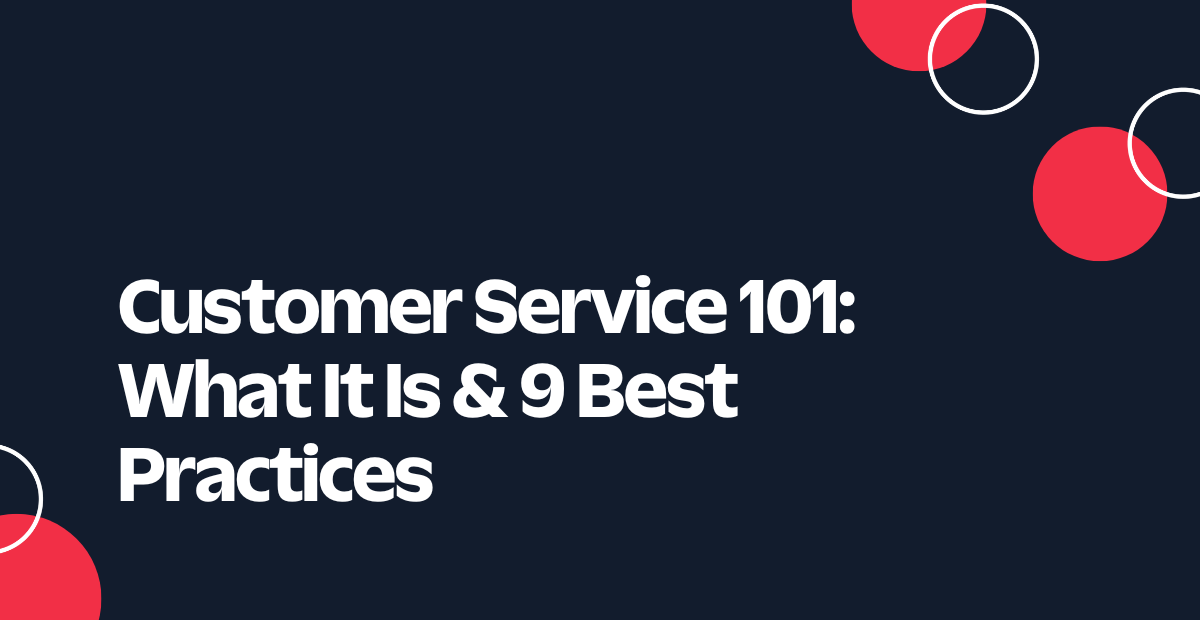Customer Service 101: What It Is & 9 Best Practices
Time to read: 6 minutes

Customers come to your business for your products or services, but it takes more than a great product to nurture relationships and keep them coming back. And since customer service is a crucial part of retaining customers and fostering loyalty, every interaction counts.
So how do you make sure you provide quality customer service? This post covers everything you need to know to create a positive customer experience.
What is customer service?
Customer service refers to the interactions customers have with your business’ support team or resources via live chat, phone, in person, or self-service. It can take many forms, like helping a customer make a purchase or troubleshooting an issue with your product or service.
The goal of customer service is to give customers the answers or support they need with as little friction as possible to cultivate the relationship and increase customer loyalty.
Customer service is part of the larger umbrella of customer experience, which refers to customers’ emotional responses to all interactions with a business.
Why is great customer service important?
Let’s take a closer look at why providing quality customer service is vital for every business.
Fostering customer retention
A customer service experience can impact the customer’s decision to continue to do business with a company.
On one hand, a positive experience can foster brand loyalty and inspire more purchases (more on that in a minute).
On the other hand, a negative experience can turn away a customer forever. In fact, 56% of consumers admit they’ll discontinue business with a company after a frustrating experience with customer support.
Increasing revenue
Great customer service has a direct impact on your business’ revenue: 59% of customers report a willingness to pay more for a great experience. Additionally, it’s generally more expensive to acquire a new customer than it is to retain an existing one, so focusing on supporting your customers saves your business money in the long run.
Bolstering brand reputation
Customers aren’t shy about sharing their experiences through reviews or comments on social media—61% of customers admit to sharing bad experiences, while 70% admit to sharing good experiences. And potential customers put a lot of stock in reviews from others.
This means that providing a positive experience not only influences the customer to keep doing business with you but also inspires them to share the love and help bolster your reputation. Social proof like this can increase trust in your brand and attract new customers.
Customer service best practices
Now that you have a clear idea of the why, let’s look at how you can offer stellar support by following these best practices in customer service.
1. Set agents up for success
Quality customer service begins by equipping agents with the right tools, training, and data to give customers the support they need.
For example, a contact center dashboard that allows agents to view customer data from every interaction gives them the necessary context to resolve customers’ issues efficiently. You can achieve this with a customer service contact center platform that integrates seamlessly with your customer relationship management software or ticket management system.
Also, training agents on every aspect of your business and processes is vital so they can answer questions confidently and troubleshoot problems.
Setting your agents up for success can reduce call time, increase customer satisfaction scores, and result in a positive experience for customers and agents alike.
2. Use automation and AI wisely
Technology can be a great partner for your agents when implemented wisely.
For example, you can use interactive voice response (IVR) in your call center to streamline call routing, allowing customers to reach the right resource or agent without a human operator. Read up on the best practices for an effective IVR.
Additionally, you can use an AI-powered chatbot to handle common customer questions and basic actions, freeing up agents’ time to help customers with complex issues. AI can also help with more advanced tasks—for example, Google Cloud Contact Center AI can surface suggested responses for contact center agents and transcribe calls to find common topics and identify customer sentiment.
3. Personalize every interaction
Customers give businesses a lot of personal data, and in return, they expect personalized experiences. Personalization makes the customer feel valued, can help streamline conversations, and most importantly, can increase revenue. According to Twilio’s State of Customer Engagement Report:
- 86% of consumers say personalization increases brand loyalty
- 57% of consumers say personalized experiences prompt them to spend more with a brand
Integrating your contact center with a customer data platform like Twilio Segment enables agents to access the data they need quickly to provide a personalized experience.
4. Respond quickly
If you’ve ever been on hold with customer service for a long time (who hasn’t?), you know how frustrating this can be. So it’s vital to respond to customers as quickly as possible.
Metrics like average waiting time can give you an idea of how long your customers typically wait for a response. And if you find that wait times are long, you can use automation tools, as discussed above, to reduce the wait by routing customers with IVR or leveraging AI to answer common questions.
In other words, speed is crucial when getting the customer connected to the right agent or resource. However, regarding the customer and agent interaction, providing quality customer service is more important. If it takes a little longer to fully resolve the customer’s issue, it’s worth it.
5. Provide self-service options
There’s a bit of a paradox in customer service: while it’s crucial to provide it, many customers don’t want to call support unless necessary. In fact, 36% of consumers say they’d rather have their internet connection go out for an entire day, deal with airport security, or shave their head than contact customer service.
So give customers other options to find the support they need. For example, a comprehensive FAQ page on your website can offer detailed answers that save customers from making a call. Other self-service resources, like package tracking via SMS and automated prescription refills, help customers help themselves without picking up the phone.
6. Offer support on every channel
Many customers today prefer to engage with businesses digitally, and offering this option can boost your revenue. In fact, companies that invested in digital customer engagement have seen revenue increase by an average of 90%. So meet your customers wherever they prefer to communicate by offering support via phone, email, live chat, SMS, WhatsApp, and other channels.
However, as you add channels to your contact center, ensure that these connect for a true omnichannel experience. This means data flows seamlessly between channels, and agents can access them all from a single dashboard.
7. Measure and analyze data
Depending on your goals, there are different metrics you can track to analyze and improve your contact center’s performance.
For example, when focused on improving the customer experience, keep an eye on your customer satisfaction score and customer retention rates. Or when analyzing agent effectiveness, measure first contact resolution and average speed of answer to understand whether they have the knowledge and resources they need to solve customers’ issues.
This data can give you insight into what works and what you need to adjust to ensure customers have a positive experience. Learn more about what these and other contact center metrics mean and how to calculate them.
8. Embrace and learn from customer feedback
In addition to contact center metrics, embrace direct customer feedback and use it to improve your contact center continuously. Gather feedback through customer surveys, comments on social media, reviews, and direct comments during customer service interactions.
While it can be difficult to take in negative feedback, it’s an opportunity to understand customers’ pain points and resolve them to provide a better experience and retain customers.
9. Adopt a customer-first mindset
You may have noticed a common theme in the best practices we’ve discussed so far: putting the customer first in everything you do. After all, that’s what customer service is.
Adopting a customer-first mindset means understanding your customer, meeting them where they’re at, and empowering your staff to address their needs. Making every customer feel valued will strengthen their relationship with your business and improve customer retention.
Learn more about how to adopt a customer-first approach.
Deliver quality customer service with Twilio Flex
Ready to put these best practices into action? You’ll need a customer service contact center platform that you can tailor to your business needs, and that’s what Twilio Flex provides.
This flexible platform helps you create the exact contact center you want, whether starting from scratch or adding new channels that work seamlessly with your existing systems.
Flex enables agents to access the customer data they need to provide personalized experiences across channels, all from a single user interface. Plus, you can tailor Flex to fit your needs and iterate continuously as your business grows.
Learn more about what you can build with a Flex contact center.
Related Posts
Related Resources
Twilio Docs
From APIs to SDKs to sample apps
API reference documentation, SDKs, helper libraries, quickstarts, and tutorials for your language and platform.
Resource Center
The latest ebooks, industry reports, and webinars
Learn from customer engagement experts to improve your own communication.
Ahoy
Twilio's developer community hub
Best practices, code samples, and inspiration to build communications and digital engagement experiences.


